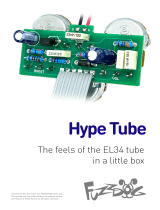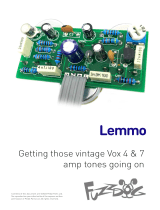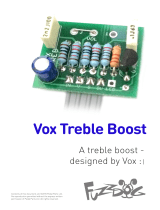Page is loading ...

Dr Boogie
Mesa Boogie Rectifier
in-a-box awesomeness
Contents of this document are ©2018 Pedal Parts Ltd.
No reproduction permitted without the express written
permission of Pedal Parts Ltd. All rights reserved.

Important notes
If you’re using any of our footswitch daughterboards,
DOWNLOAD THE DAUGHTERBOARD DOCUMENT
•Download and read the appropriate build document for the daughterboard
as well as this one BEFORE you start.
•DO NOT solder the supplied Current Limiting Resistor (CLR) to the main
circuit board even if there is a place for it. This should be soldered to the
footswitch daughterboard.
POWER SUPPLY
Unless otherwise stated in this document this circuit is designed to be
powered with 9V DC.
COMPONENT SPECS
Unless otherwise stated in this document:
•Resistors should be 0.25W. You can use those with higher ratings but
check the physical size of them.
•Electrolytics caps should be at least 25V for 9V circuits, 35V for 18V
circuits. Again, check physical size if using higher ratings.
LAYOUT CONVENTIONS
Unless otherwise stated in this document, the following are used:
•Electrolytic capacitors:
Long leg (anode) to square pad.
•Diodes:
Striped leg (cathode) to square pad.
•ICs:
Square pad indicates pin 1.

Schematic + BOM
R1 2M2
R2 680K
R3 68K
R4 1K8
R5 2M2
R6 680K
R7 470K
R8 1K8
R9 470K
R10 1M
R11 3K9
R12 330K
R13 220K
R14 1K8
R15 10K
R16 4K7
R17 2K2
R18 100R
R19 100R
R20 5K1**
C1 100n
C2 220p
C3 22n
C4 1u
C5 2n2
C6 1n
C7 22p
C8 220p
C9 22n
C10 1u
C11 1n
C12 22n
C13 220p
C14 1u
C15 220n
C16 6n8
C17 220n
C18 33n
C19 4n7
C20 100u elec
C21 100u elec
Q1-5 J201*
D1 1N4001
VOL 100KA
GAIN 1MA
TREB 25KA
MID 5KB**
BASS 100KA
PRES 10KB
T1-4 100K TRIM‡
**The PCB has been designed so you can use the SMT equivalents of these FETs.
We recommend a couple of substitutes too. See next later in the doc.
***The design calls for a 2.5K pot for MIDS. R20 in series with a 5KB works fine.
If you have a 2.5KB pot, kudos! Omit R20.
‡ If you want to be really precise with your biasing you can use multi-turn trimmers.
These values are based on
the Gaus Markov mods
which make the circuit
much better than the
stock values.

The power and signal pads on the PCB conform
to the FuzzDog Direct Connection format, so
can be paired with the appropriate
daughterboard for quick and easy offboard
wiring. Check the separate daughterboard
document for details.
Be very careful when handling and soldering
the FETs. They’re very sensitive to heat and
static.
Snap the small metal tag off the pots so they
can be mounted flush in the box.
You should solder all other board-mounted
components before you solder the pots. Once
they’re in place you’ll have no access to much of
the board. Make sure your pots all line up nicely.
The best way to do that is to solder a single pin
of each pot in place then melt and adjust if
necessary before soldering in the other two
pins. Ensure you leave a decent gap between
the pot body and the PCB otherwise you risk
shorting out the circuit.
PCB layout ©2018 Pedal Parts Ltd.

BIASING
See the next page for the test wiring instructions.
Once you have everything set up, come back here.
You need to adjust the trimmers T1-4 to adjust the
bias voltage at the drain of each of the FETs (Q1-4).
To do this, set your multimeter to DC Voltage,
with a range that includes 9V.
Put your common probe on any ground point on the board, or one of your jack
ground lugs. It helps if this probe is a clip-type rather than just a point.
Check your supply voltage by putting the second probe on the V pad of the PCB.
Now place the second probe onto the drain pad of Q1 (shown in red above).
Adjust your trimmer until you get to around half your supply voltage.
We tend to have it slightly above as this makes squealing much less likely
(i.e. if our supply is 9V we’ll adjust to 5V).
Repeat for each of the FETs. The trimmer numbers correspond with the FET
number - T1 adjusts Q1 etc.
Don’t get hung up on exact numbers. Tweak until you like what you hear, but
around half supply is the best starting point.
You may get some squeal at first. Just keep tweaking until it goes. Setting the bias
voltage of Q1 higher works well. Some people recommend having it as high as 7V.
It’s totally down to personal taste.
TRANSISTOR SUBSTITUTIONS
You don’t have to use J201. We liked the combination of 2N5457 for Q1-2,
with J201 for Q3-5. Others may work better for you. Just check your pinouts.

Test the board!
Check the relevant daughterboard document for more
info before you undertake this stage.
UNDER NO CIRCUMSTANCES will troubleshooting help
be offered if you have skipped this stage. No exceptions.
Once you’ve finished the circuit it makes sense to test is before starting on the switch and LED
wiring. It’ll cut down troubleshooting time in the long run. If the circuit works at this stage, but it
doesn’t once you wire up the switch - guess what? You’ve probably made a mistake with the switch.
Solder some nice, long lengths of wire to the board connections for 9V, GND, IN and OUT. Connect
IN and OUT to the jacks as shown. Connect all the GNDs together (twist them up and add a small
amount of solder to tack it). Connect the battery + lead to the 9V wire, same method. Plug in. Go!
If you’re using a ribbon cable you can tack the wires to the ends of that. It’s a lot easier to take them
off there than it is do desolder wires from the PCB pads.
If it works, carry on and do your switch wiring. If not... aw man. At least you know the problem is
with the circuit. Find out why, get it working, THEN worry about the switch etc.
Your completed circuit board
including pots

Wiring shown above will disconnect the battery when you remove the jack plug
from the input, and also when a DC plug is inserted.
The Board GND connections don’t all have to directly attach to the board. You
can run a couple of wires from the DC connector, one to the board, another to
the IN jack, then daisy chain that over to the OUT jack.
It doesn’t matter how they all connect, as long as they do.
This circuit is standard, Negative GND. Your power supply should be Tip
Negative / Sleeve Positive. That’s the same as your standard pedals (Boss etc),
and you can safely daisy-chain your supply to this pedal.
L
E
D
BOARD
OUT
BOARD
9V
BOARD
GND
BOARD
GND
BOARD
GND
BOARD
INPUT
BATTERY
+
IN
OUT
L
E
D
BOARD
GND
BOARD
9V
+
Wire it up (if using a daughterboard please refer to the relevant document)

This template is a rough guide only. You should ensure correct marking of your
enclosure before drilling. You use this template at your own risk.
Pedal Parts Ltd can accept no responsibility for incorrect drilling of enclosures.
FuzzDog.co.uk
Recommended drill sizes:
Pots 7mm
Jacks 10mm
Footswitch 12mm
DC Socket 12mm
Drilling template
Hammond 1590BB
91 x 116 x x 31mm
30mm
30mm
It’s a good idea to drill the holes for the pots 8mm to give
yourself some wiggle room unless you’re a drill ninja
/









